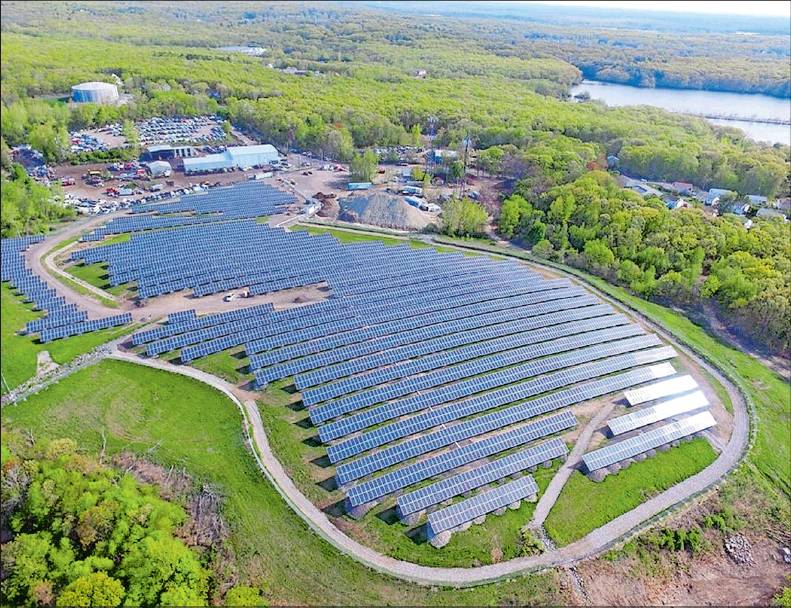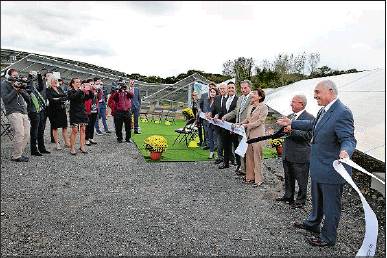SOLAR POWER
A sunnier prospect
Developers: Building on brownfields has a bright side
By Alex Kuffner Journal Staff Writer
NORTH PROVIDENCE — It’s hard these days to find a solar farm in Rhode Island that everybody can like, what with the debate over clearing forestland to make way for vast fields of photovoltaic panels in rural parts of the state.
But if there is an ideal, the 2.6-megawatt array on a closed landfill here may be an example.
For one, the project built by Warwick-based Southern Sky Renewable Energy is on 12 acres of contaminated land that couldn’t be used for anything else. For another, it’s out of the way and ringed by trees, making it hard to see from nearby homes.
And then there’s this: it will generate revenue for the town from taxes and rent and offset municipal energy bills, all while feeding a steady stream of clean, renewable energy into the electric grid. Southern Sky estimates that North Providence will clear $5.1 million over the 25-year life of the 6,700 panels the company finished installing a few weeks ago.
On Wednesday, Gov. Gina Raimondo joined North Providence Mayor Charles Lombardi, Senate President Dominick Ruggerio, Southern Sky president Ralph Palumbo and others for the official commissioning of the project.
“This is one example of how we do business in Rhode Island,” the governor told the small gathering. “You don’t have to choose between being pro-environment and pro-business. This is both. This creates jobs, this generates revenue for the town, and it helps the environment and helps meet the challenges of climate change.”
The ribbon-cutting comes at a pivotal moment for solar power in Rhode Island. The industry has gone from sleepy to booming in just a few years with the passage of a suite of state laws that sweetened incentives for developers and the Raimondo administration’s adoption of ambitious targets for renewable energy.
While the pace of rooftop and other residential installations has certainly picked up, the real action is with big arrays of ground-mounted panels that can cover 100 acres or more. Not that long ago, the biggest solar projects in Rhode Island had capacities of two or three megawatts apiece. Companies are now working on projects 10 times bigger.
Many are being targeted for forests, open space and underused farmland that offer the easiest path to development. While supporters tout the benefits of creating new sources of renewable energy, detractors have raised objections because some of the projects require taking down thousands of trees.
Southern Sky, one of the largest developers in the state, if not the largest, has found itself at the center of the controversy. Its 21.5-megawatt project nearing completion in Cranston covers 108 acres and required cutting down 60 acres of trees.
And another proposal by the company in Hopkinton has also drawn the ire of some residents of that town. The Brushy Brook project would total 58 megawatts on 144 acres of a 358-acre site.
Although neighbors have backed the plan, saying it is preferable to housing, others have come out against it because it would require taking out a large area of woods. Southern Sky last week said it would preserve 59 acres on the property near the Arcadia Management Area to make the project more palatable to the objectors.
But Palumbo is also building solar farms on former industrial sites known as brownfields, including a 6.3-megawatt array on the former Leviton Manufacturing site in Warwick, a nearly 4-megawatt installation on a capped landfill in Johnston and the North Providence installation.
Construction of the latter project off Smithfield Road began last May after nearly six years of efforts to redevelop the site for solar power. Two other developers pulled out before Palumbo stepped in, said Mayor Lombardi, who thanked him for following through.
“I think that this barren piece of property is going to become useful and appreciated by the taxpayers of the town,” Lombardi said.
It is not the first closed landfill in Rhode Island to be used for solar. Five years ago, CME Energy, of Boston, installed solar panels on a landfill in East Providence and is now working on an expansion. And earlier this year, Kearsarge Energy, also of Boston, completed two landfill projects in South Kingstown.
Palumbo said it will take both landfill projects and the typically bigger proposals on undeveloped land to meet the state’s renewable energy goals. He acknowledged the trade-off in cutting down woods to make way for solar panels.
“It’s a tough equation,” he said in an interview. “There are challenges.”
The state this summer announced new incentives to steer solar power to brownfields, and a group of planners, developers and environmental groups are working with officials on guidelines for development. Prospective buyers of the power are also starting to put restrictions on what kinds of projects they’ll consider in a bid to prevent the clear-cutting of trees, according to Scott Millar of Grow Smart Rhode Island.
“Obviously if you can use a brownfield or use a rooftop, it’s preferable,” Governor Raimondo said in an interview. “So yes, that is ideal, and that’s why we’re trying to encourage it.”
— akuffner@ providence-journal.com
(401) 277-7457


